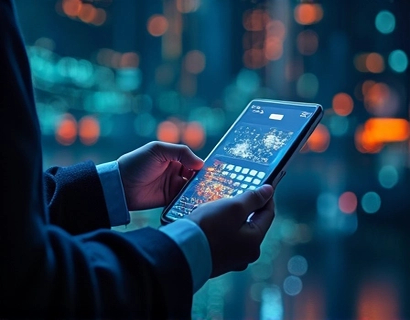Innovative Universal Apps: A Comprehensive Guide to Accessibility and Productivity Enhancements
In the rapidly evolving landscape of technology, the concept of universal apps has emerged as a transformative force, bridging the gap between advanced tools and universal accessibility. These groundbreaking applications are designed to enhance productivity and creativity for users of all abilities, ensuring that technology is not only powerful but also inclusive. This comprehensive guide delves into the world of universal apps, exploring their features, benefits, and the innovative technologies that make them possible.
The primary goal of universal apps is to provide an optimal user experience across different devices and platforms while accommodating a wide range of user needs. These apps are built with accessibility in mind, incorporating features that cater to users with various disabilities, including visual, auditory, motor, and cognitive impairments. By doing so, they not only improve the quality of life for individuals with disabilities but also enhance the overall user experience for everyone.
Understanding Universal Design in Apps
Universal design in apps is a approach that ensures products are usable by all people, to the greatest extent possible, without the need for adaptation or specialized design. This philosophy extends beyond physical products to digital interfaces, where it manifests through intuitive navigation, clear typography, and flexible interaction methods. For instance, apps that support voice commands, gesture recognition, and customizable interfaces exemplify the principles of universal design.
One of the key benefits of universal design is its ability to create a more inclusive environment. By removing barriers and providing multiple ways to interact with content, these apps make technology accessible to a broader audience. This inclusivity fosters a more diverse and engaged user base, driving innovation and creativity across various sectors.
Enhancing Accessibility Through Advanced Technologies
Modern universal apps leverage cutting-edge technologies to push the boundaries of accessibility. Artificial Intelligence (AI) and Machine Learning (ML) play a crucial role in creating adaptive and intelligent interfaces. For example, AI-powered text-to-speech and speech-to-text features enable users with visual or motor impairments to interact with apps more effectively. These technologies can also assist in real-time translation, making content accessible to non-native speakers.
Augmented Reality (AR) and Virtual Reality (VR) are other transformative technologies that enhance accessibility. AR can provide visual aids and context-sensitive information, helping users with cognitive disabilities navigate complex environments. VR, on the other hand, offers immersive experiences that can be tailored to individual needs, making education and training more engaging and effective.
Productivity Boosters: Apps for Efficiency and Creativity
Universal apps are not just about accessibility; they are also powerful tools for boosting productivity and creativity. These apps offer a range of features that streamline workflows, enhance collaboration, and inspire innovative thinking. For instance, note-taking apps with voice recognition and cloud synchronization allow users to capture ideas quickly and access them from any device. Project management tools with customizable interfaces and assistive technologies ensure that teams can collaborate seamlessly, regardless of individual abilities.
Creative apps that support universal design principles empower artists, writers, and designers to express themselves more freely. Drawing and painting apps with customizable brush settings and voice commands enable users with motor impairments to create stunning artwork. Writing tools with predictive text and speech recognition help writers overcome barriers and focus on their craft.
Key Features of Universal Apps
To truly understand the value of universal apps, it's essential to examine their key features. These apps typically include:
- Adaptive interfaces that adjust to user preferences and abilities
- Multiple input methods, such as touch, voice, and gestures
- High contrast modes and customizable text sizes for better visibility
- Support for assistive technologies like screen readers and magnifiers
- Intuitive navigation and clear, concise instructions
These features work together to create a seamless and inclusive user experience, ensuring that everyone can benefit from the app's functionality.
Real-World Applications and Success Stories
The impact of universal apps is evident in various real-world applications. In education, apps that provide real-time translation and visual aids have revolutionized learning for students with hearing or visual impairments. In the workplace, universal project management tools have enhanced collaboration and productivity, breaking down barriers between teams and individuals with different abilities.
A notable success story comes from the field of healthcare. Apps designed for universal accessibility have enabled patients with disabilities to manage their health more effectively. For example, medication reminder apps with voice alerts and customizable interfaces help users remember to take their medication on time, improving their overall health outcomes.
Future Trends in Universal App Development
As technology continues to advance, the future of universal app development holds exciting possibilities. One trend is the integration of 5G networks, which will provide faster and more reliable connectivity, enhancing the performance of apps that rely on real-time data and cloud computing. This will be particularly beneficial for AR and VR applications, making them more responsive and immersive.
Another trend is the increased use of biometric data and wearable devices to create more personalized and adaptive user experiences. Apps that can monitor a user's physical and emotional state and adjust their functionality accordingly represent the next frontier in universal design. This personalized approach not only improves accessibility but also enhances the overall user experience.
Conclusion
Universal apps are at the forefront of a technological revolution that is making advanced tools accessible and beneficial to everyone. By combining cutting-edge technologies with a commitment to inclusivity, these apps are not only enhancing productivity and creativity but also fostering a more equitable society. As developers continue to innovate and push the boundaries of what's possible, the future of universal apps looks brighter than ever. Embracing these tools can lead to significant improvements in both personal and professional lives, making technology a true ally for all users.











































